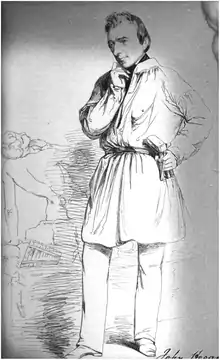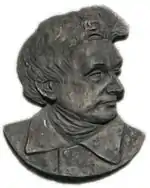John Hogan (sculptor)
John Hogan (October 14, 1800 – 1858) was one of Ireland's greatest sculptors.

Life
John Hogan was born on October 14, 1800 in Tallow, County Waterford, the third child of John Hogan, a carpenter and builder of Cove Street, Cork and Frances Cos, the great-granddaughter of Sir Richard Cox, Lord Chancellor of Ireland from 1703 to 1707. As the family felt that she had married beneath her station, she was disinherited.[1]
At the age of fourteen, Hogan was placed as clerk to an attorney, where he spent much of his time carving figures in wood. After two years, he chose to be apprenticed to the architect Sir Thomas Deane, where his talents for drawing and carving were developed. He carved balusters, capitals, and ornamental figures for Deane's buildings. At the completion of his apprenticeship in March 1820, Deane encouraged him to consider taking up sculpture as a profession. For the next three years, Hogan attended lectures on anatomy, copied casts of classic statuary in the Gallery of the Cork Society of Arts, and made anatomical studies in wood of feet, hands, and legs. His first work to attract notice was a life-size figure of Minerva for an insurance building built by Deane.[1]
In 1821, Hogan carved twenty-seven statues in wood for the North Chapel in Cork for the reredos behind the high altar. After subsequent cathedral renovations, these are now positioned in decorative plasterwork over the nave.[2] He also did a bas-relief of the "Last Supper" for the altar. This work kept him employed for about a year.
In 1823, noted engraver William Paulet Carey visited Cork, and impressed with Hogan's talent began to publicize his work in order to raise subscriptions for him to study in Italy. Hogan arrived in Rome, by way of Dublin and Liverpool, in 1824. He worked in the Galleries of the Vatican, but could not afford a studio. Additional subscriptions allowed him to improve his situation, rent a studio, purchase marble, and hire models. Danish sculptor Bertel Thorwaldsen said to him, "My son, you are the best sculptor I leave after me in Rome."[1]
In 1829, Hogan visited Ireland, bringing several works with him. The Royal Arts Society provided a venue for an exhibition. The Dublin Society awarded him a gold medal.

Hogan's best known work and masterpiece are the three versions of the statue of The Redeemer in Death or The Dead Christ. Created in flawless Carrara marble, the first version (1829) is located in St. Therese's Church, Dublin, Ireland, the second (1833) in St. Finbarr's (South) Church, Cork, Ireland and the third and final version (1854) is located in the Basilica of St. John The Baptist, Newfoundland. Other works by Hogan include the Sleeping Shepherd and The Drunken Faun. Hogan assured his international reputation in 1829 with The Dead Christ; thereafter, his creations were snapped up by Irish bishops visiting his Rome studio.

In 1837 he was elected a member of the Virtuosi del Pantheon. During the next several years, he had several works in hand, including a marble statue of Daniel O Connell, for the Repeal Association. The statue stands today at City Hall Dublin, the same spot where O'Connell gave his first speech against the Act of Union in 1800.[3]
Carlow Cathedral was started in 1828 and completed in 1833, and was the brain-child of the Bishop of Kildare and Leighlin, James Doyle (J.K.L.), a prominent champion of Catholic Emancipation, who died the year after the Cathedral was opened and is interred in its walls. A sculpture, by John Hogan, in memorial to the Bishop was finished in 1839.[4]In 1840, a monumental group in memory of Bishop Doyle, founder of Carlow Cathedral was brought to Dublin and exhibited at the Royal Exchange. the statue of Bishop Doyle is in the Cathedral of the Assumption, Carlow, as is a second Hogan work depicting the Holy Family.[5]
In 1838, Hogan married Cornelia Bevignani. After twenty-four years in Rome, the revolutionary movement in Italy, brought him to leave Rome in 1848 and return with his family to Ireland. At first, he found little work in the aftermath of the famine years, but gradually commissions increased. Hogan could be impatient with ignorance, intolerant of professional inferiority, and independent. He held aloof from other artists and refused to join the Hibernian Academy.[1]
A year before his death, his health began to fail and he could no longer work. His son, John Valentine Hogan assisted at his studio, and completed some of the work. John Hogan died at his house, on March 27, 1858 and was buried at Glasnevin.
See also
References
- Strickland, Walter G., "John Hogan, Sculptor", A Dictionary of Irish Artists, 1913
 This article incorporates text from this source, which is in the public domain.
This article incorporates text from this source, which is in the public domain. - "Cathedral Parish, Cork, Ireland", Cathedral of St Mary and St Anne
- "John Hogan", Encyclopedia of Irish Plastic Art
- "Carlow Cathedral". Carlow Town.com. Archived from the original on 2007-11-17. Retrieved 2007-12-09.
- Hickey, Francis. "If Carlow Cathedral Could Speak", Carlovania, Old Carlow Society, December 1954, p. 34
External links
| Wikimedia Commons has media related to John Hogan. |
